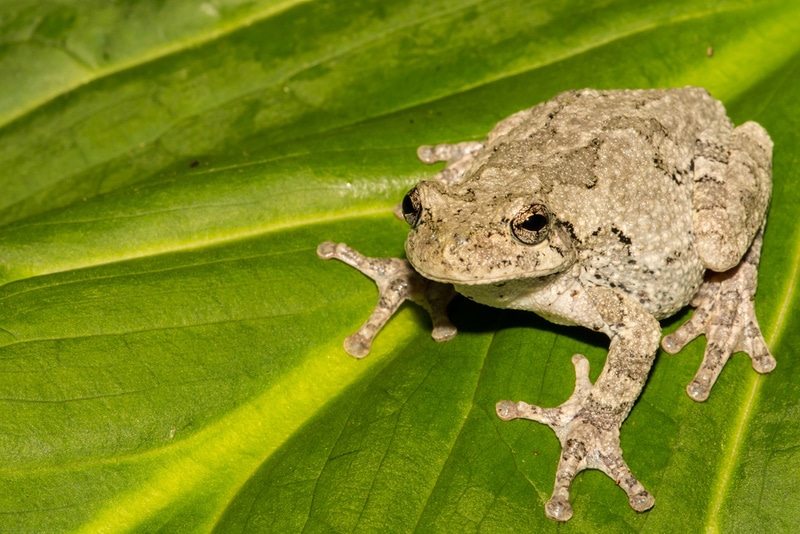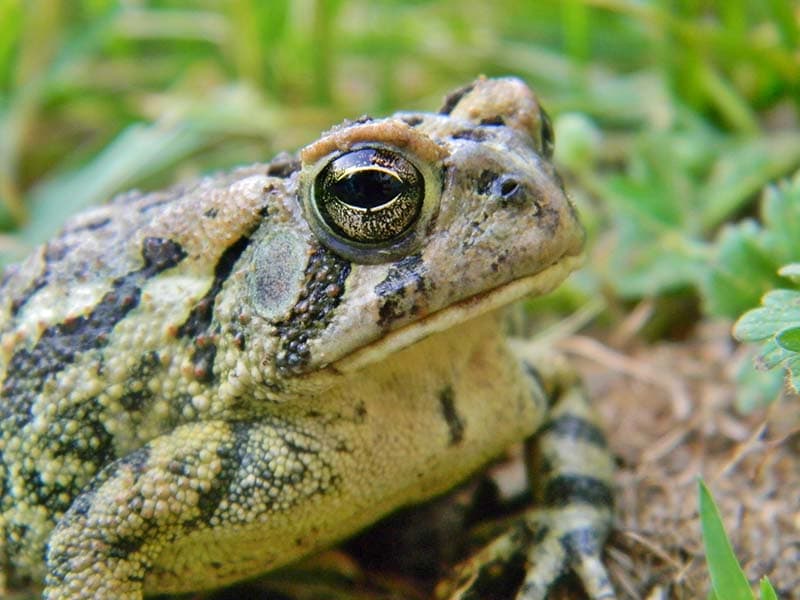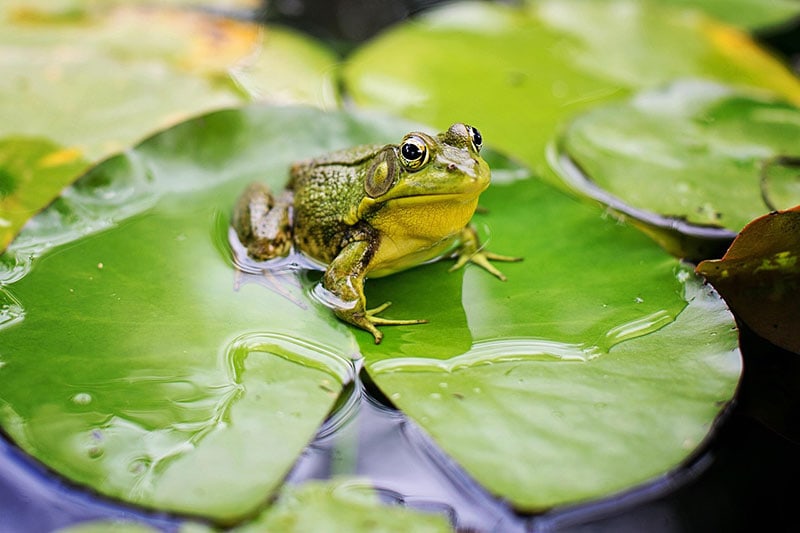Burmese Chubby Frog: Care Guide, Lifespan, Diet, Pictures & More
Updated on
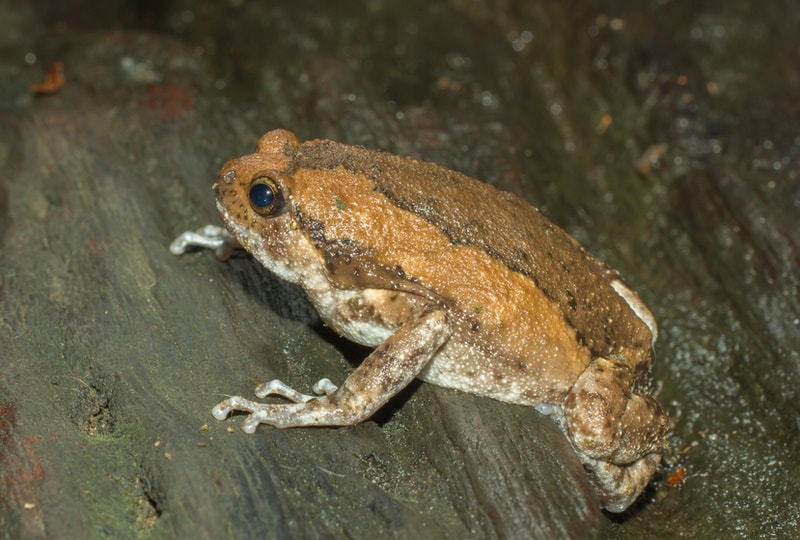
Burmese Chubby frogs are also known as Asian Painted frogs. These frogs are noticeably chubby, hence their name. They’re also known as the Banded Bullfrog, as they have a distinct banded pattern along their back. They are pretty small frogs, growing only to 3 inches or so. However, you may find some as small as 2 inches.
These frogs are pretty laid-back. They’re nocturnal, so they’re only active at night. If you decide to purchase one as a pet, you probably won’t see them doing much activity. They like to hide in their burrow or leaf litter during the day to avoid predators.
| Size: | Up to 3 inches |
| Lifespan: | 6 to 8 years |
| Color: | Brown, gray, or green |
| Suitable for: | Beginner reptile owners |
| Temperament: | Docile and low-maintenance |
| Diet: | Small insects and invertebrates (think ants) |
| Tank Set-Up: | Bark and mulches deep enough to burrow into |
| Minimum Tank Size: | 10 gallons |
| Suitable Tank Mates: | None; they are solitary |
These frogs have a very fast breeding rate. Therefore, they are considered a pest in some areas. They have been able to establish themselves in areas outside of their native range, where they are invasive.
Burmese Chubby Frog Characteristics
Burmese Chubby Frog Overview
Burmese Chubby Frogs are native to Southeast Asia. They have been inadvertently introduced to other areas, though. For instance, they are currently invasive in South Florida. They thrive in human-inhabited areas like rice paddies.
These robust frogs have stubby limbs and a big round body. They typically grow to about 2 to 3 inches long and have a dark brown coloration with a lighter belly. Along either side of their body, they possess thick bands that can vary from a rusty tan to almost pink. This coloration is one reason they’re often called “painted frogs.”
Males and females have slightly different colorations. Males have a dark throat patch, while females do not. Males show this off while breeding, which is why they have darker throats. These plump frogs are typically elusive and active at night. They prefer to hide in leaf litter or dig into soft soil, making them less than thrilling pets since they are not very active.
During monsoon season, these creatures become more active and louder in the wild. They make loud bellowing noises to attract mates. Their breeding pools are briefly around and dry up after the breeding season, so their tadpoles develop very quickly. Despite human development, the population of Chubby Frogs has remained stable. These frogs live fine next to people, which is one reason their population is doing so well.
That said, these frogs are able to spread into other areas with ease thanks to their rapid reproduction rate. Therefore, some areas consider them pests—not pets.

Burmese Chubby Frog Cost
Chubby frogs are a great choice for beginners due to their relatively easy care (at least compared to other frogs). However, you still have to be committed to their well-being. They also live quite a long time, so you must be willing to commit to their care for around 7 years.
It is important to exercise caution when buying Chubby frogs as most sold in pet stores are caught from the wild. These wild-caught frogs may not be well-suited for captivity, unlike their captive-bred counterparts. Burmese Chubby frogs are relatively affordable at around $10 to $30. Purchasing from a breeder may be slightly more expensive, but these frogs typically don’t get any more expensive than $50.
Wild-caught specimens might be available at a lower price, but it’s essential to consider the ethical implications of purchasing wild-caught animals.
Care Guide & Tank Set Up
Tank Size
We recommend providing Chubby frogs with at least a 10-gallon tank, preferably one that is horizontal. While these frogs can climb, they are terrestrial, which means they spend most of their time on the ground. Therefore, horizontal space is more important than vertical space.
If you’re thinking of keeping Chubby frogs as pets, you don’t need to provide them with a very large vivarium. Even though they are relatively inactive compared to other frogs, a 10-gallon tank would be enough space for them.
Of course, when you can go bigger, you should. These frogs will enjoy more room, just like most other species.
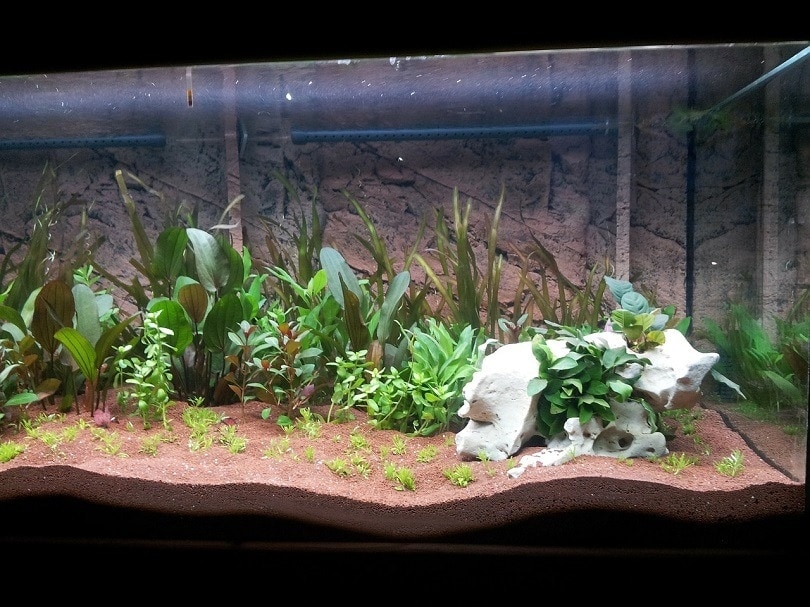
Substrate
These frogs like to burrow, so the substrate is important. You’ll need at least 4 inches of substrate for their enclosure, which should provide adequate room for burrowing. Frogs will burrow for both shelter and enrichment, so this isn’t a behavior you can ignore. Coco coir is the best option for Burmese Chubby frogs. It’s widely available and relatively cheap. However, you can also use fine soils, but these turn to mud when wet and don’t hold humidity well.
To enhance the substrate’s humidity retention, adding mosses like sphagnum moss can be beneficial. While it may be slightly more expensive, sphagnum moss is outstanding at absorbing moisture. If you live in a very dry area, this added moisture retention can be extremely beneficial. Furthermore, adding leaf litter and moss can make the tank look very natural, as well.
Avoid using sand or gravel in the substrate mix, as ingesting these particles can lead to impaction and harm your frog’s digestive system. Instead, choose coconut fiber or a similar substrate.
Humidity
Chubby frogs require a pretty high humidity level at 70% to thrive. You’ll need to use a functioning hygrometer to ensure that the humidity stays at the proper level. Otherwise, health problems may ensue.
To keep the humidity at the proper level, you’ll need to mist the tank regularly and choose a moisture-retaining substrate. To maintain a healthy enclosure, it’s important to mist it daily while keeping the substrate slightly damp but not too wet. If the substrate becomes too wet, mold growth and the spread of harmful bacteria can occur, so be sure to avoid this.
You can maintain a humid environment through evaporation by incorporating a large, shallow water bowl in the enclosure, as well. To ensure your frog’s safety, it is important to only use distilled or dechlorinated water in their enclosure. Tap water containing chlorine and other additives can be harmful to their health.
Lighting
Chubby frogs do not need a special light. In fact, they don’t really need any light at all. However, they do need a day/night cycle. You can simply place your frog in a room that gets some sunlight throughout the day to attain this.
Avoid putting the frog in areas where you use a lot of artificial light at night, like by a TV. It is important to avoid placing the tank of Chubby frogs in direct sunlight as it can result in overheating. To provide light for the frogs, you can put an aquarium light above the tank and connect it to a timer. If you want to have live plants in the enclosure, you can use fluorescent lighting. However, it is crucial to make sure that the lighting is not too strong, as it can harm the frog’s delicate skin by causing it to dry out.
In case the lights increase the temperature, you can lower the heat pad thermostat setting to keep the appropriate temperature for the Chubby frogs. After adding the lighting, it is essential to check the temperature and adjust it accordingly. The tank’s appearance can also benefit from the lighting, although this is mainly a matter of personal preference.

Heating
As a tropical species, these frogs need high temperatures to thrive. Preferably, the temperature range should be between 75 and 80 °F during the day and 68–70 °F at night.
These frogs are very sensitive to drying out, so it’s vital that they aren’t overheated. Heat lamps can be particularly troublesome, as they tend to suck moisture out of the air. You cannot use a heating pad directly on the floor of the terrarium, either. Because these frogs burrow, they can come into contact with the bottom of the tank and burn themselves.
The best way to use a heating pad is to attach it to the exterior wall on the back of the enclosure. Insulate the heating device with a tile to emit heat into the tank and stop heat loss to the outside. Always use a thermostat to regulate the heat pad and prevent overheating.
Be sure to use a thermometer in the enclosure to monitor the temperature. You’ll need to adjust the temperature as necessary to ensure it remains within the proper range.
Things to Know When Owning a Burmese Chubby Frog
Food & Diet Requirements
Burmese Chubby frogs belong to the narrow-mouthed frog family, which means they have a relatively small mouth in proportion to their size. As a result, they are unable to consume large prey like some other frog species. To keep them healthy and happy, it’s essential to feed them small insects that are appropriate for their size.
In the wild, these frogs are known for their love of ants, which make up a significant part of their diet. However, in captivity, they also enjoy small crickets, which are easier to find and are a great source of protein with a suitable calcium-to-phosphorus ratio and low lipid content. This makes them the perfect food for Burmese Chubby frogs.
It’s important to avoid feeding your frog crickets that are too large for their mouth to prevent injury. For variety, you can occasionally include mini mealworms, wax worms, or small grasshoppers, but avoid feeding them too often, as rich foods can lead to obesity. While it’s not strictly necessary, we recommend gut-loading your crickets before feeding them to your frog. This involves feeding the crickets with a nutritious diet so that they, in turn, pass on those nutrients to your frog.
It’s crucial to feed adult Chubby frogs every other day, offering two to three medium-sized crickets per feed. Juvenile frogs, on the other hand, require more frequent feeding as they are still growing, so it’s best to feed them every day.

Water/Liquid Requirements
These frogs are mostly found on the ground and are known as terrestrial frogs. As a result, they do not require a large amount of water in their enclosure.
To keep your pet frogs healthy, it’s important to provide them with a source of water. We suggest using a large, shallow water bowl that cannot be easily tipped over. Keep in mind that the frog may try to dig underneath the bowl, so it’s important to check it regularly to ensure it remains full.
Size & Growth Rate
Burmese Chubby frogs are quite small, which is one reason they are so popular. They only reach about 2 to 3 inches long when fully matured, though they fully mature in only a few months.
As adults, they’re robust frogs despite their smaller size, hence their name “chubby.”
Lifespan and Health Conditions
Burmese Chubby frogs live for about 6 to 8 years, which is long for a frog. However, proper care is required for them to live their whole lifespan.
Frogs are prone to intestinal impaction, a common health problem caused by ingesting non-edible items like substrate in large quantities. While mild cases can be treated at home, severe cases require immediate attention from a trained veterinarian. Prevention is key to avoiding this issue altogether.
Thankfully, it’s easy to prevent intestinal impaction. Simply use proper substrate in your frog’s enclosure and avoid using gravel or sand. It’s also important to provide appropriately sized prey, such as smaller crickets.
Obesity is another health concern for frogs. Overweight frogs can experience significant health complications, so it’s important to maintain a stable diet of insects and occasional fatty treats. Avoid overfeeding and limit lipid-rich foods like wax worms to around once or twice a month.
- Obesity
- Impaction
Male vs. Female
It is almost impossible to determine males from females in this species, especially outside of breeding season or in very young frogs. For the most part, males and females are pretty much the same. There isn’t a huge reason to choose one gender over another.
3 Little-Known Facts About the Burmese Chubby Frog
1. They’re often considered an invasive species.
Because these frogs are so good at surviving next to humans, they tend to push out native species. When pet owners adopt these frogs but don’t commit to taking care of them for their whole lifespan, it isn’t odd for them to be released. In this way, these frogs can travel far outside of their native range.
2. Despite their small size, these frogs can be loud.
If you’re looking for a quieter pet, these frogs aren’t the best option. They’re actually surprisingly loud for their smaller size.
3. They don’t like to be handled.
Chubby frogs don’t like to be handled all that much. Therefore, they’re best for those who don’t feel the need to handle their pets.

Final Thoughts
Chubby frogs can make great pets for beginner reptile enthusiasts. Their care requirements aren’t as complicated as many other frogs, so they do very well for beginners. They’re also fairly docile and healthy, which are added bonuses.
You can keep these frogs safely in a 10-gallon aquarium, though 15-gallons may be better. They don’t grow very large, but they do like to burrow. Therefore, you’ll need to use enough substrate to provide them with some burrowing room. Plus, these frogs are also widely available and can be found at most pet stores.
Featured Image Credit: boyphare, Shutterstock

